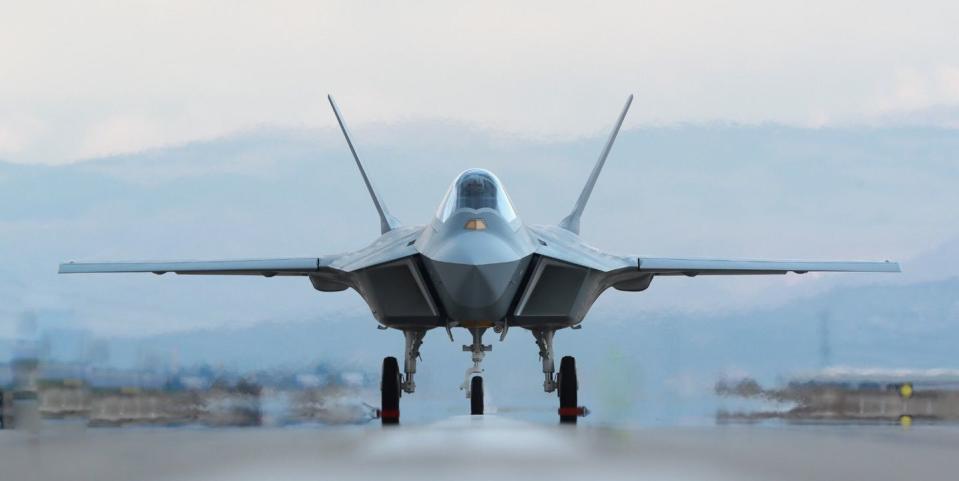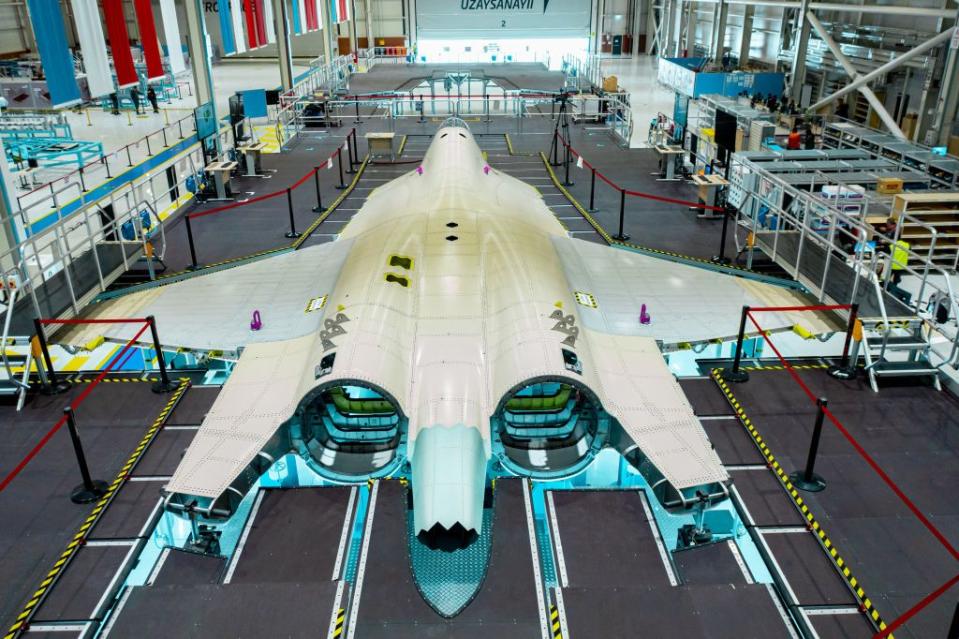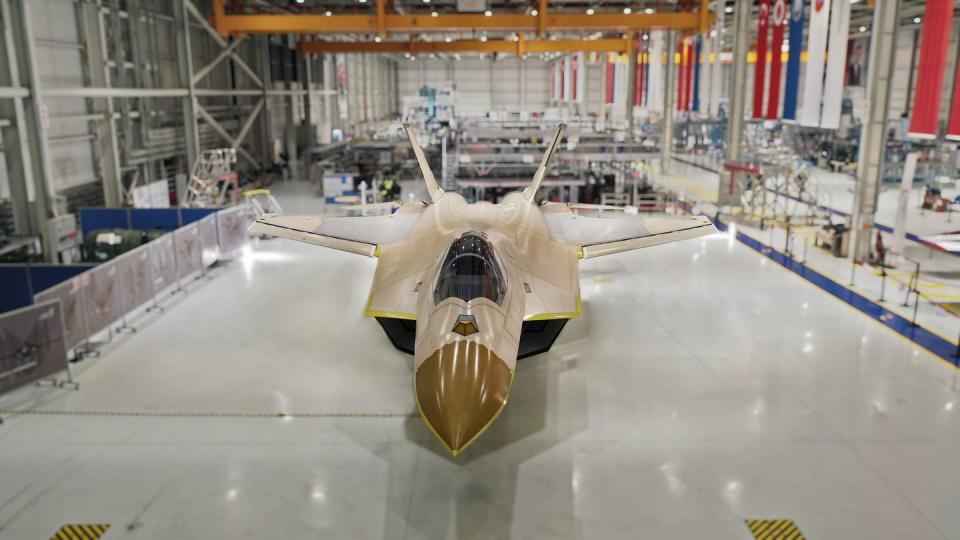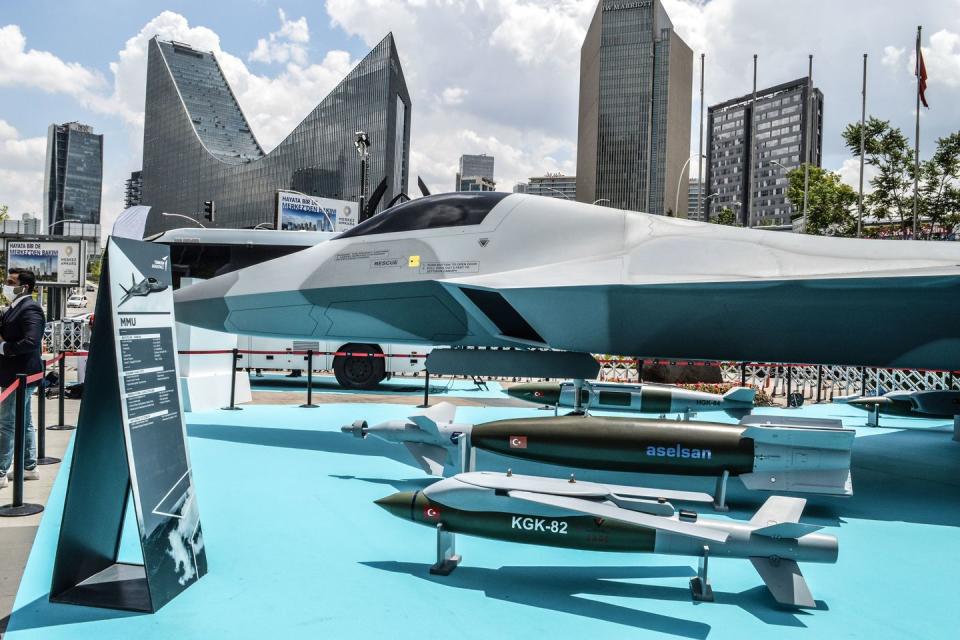Turkey’s Next-Gen Fighter Jet and Stealthy Drone Are Here—and Massively Important

Last week, Turkish Aerospace Industries (TAI) proudly showed off its TF-X fighter, which is now on the move—even though it’s still land-bound for a little while. Also known by its program name, the National Combat Aircraft (MMU), Turkey’s first homegrown fighter jet began taxi trials on March 16. Firing up its F110 turbofans, the jet advanced down a runway in Ankara without mishap.
A few days later, Turkish president Recep Erdogan attended the aircraft’s formal unveiling at a ceremony commemorating the World War I battle of Gallipoli. The 21-meter-long jet falls in between the U.S.’s F-22 and F-35 in size, and closely resembles the former.
Besides the TF-X, the event showcased a new flying wing stealth drone called the Anka-3 and the Hürjet supersonic trainer/ground-attack aircraft, conceptually reminiscent of South Korea’s successful FA-50 Golden Eagle. A prototype of the Hürjet made its first taxi tests on March 18.
İnanç, emek, başarı... Bu sevinci bizlere yaşattıkları için tüm çalışma arkadaşlarıma bir kez daha sonsuz teşekkürlerimi sunuyorum.@SavunmaSanayii pic.twitter.com/twT0H3Vs0H
— Temel Kotil (@Temel_Kotil) March 18, 2023
The Political Struggles of Turkey’s Future Jet Fighters
Erdogan, staring down the barrel of a tough election this May, undoubtedly hopes the prototype aircraft will highlight Turkey’s progress toward a self-sufficient defense industry—a drive that has been made even more necessary due to its worsening relationship with former primary arms suppliers Germany and the United States over the last decade.
The twin-engine TF-X was originally intended to be a more air-superiority-oriented complement to Turkey’s expected fleet of F-35 stealth fighters. The F-35s would replace Turkey’s aging fleet of F-4 Terminators 2020s while the TF-X would replace Turkey’s F-16s.
But after Erdogan chose to purchase S-400 surface-to-air missile systems from Russia, Turkey was ejected from the F-35 program over fears that Russia might use backdoors installed in those systems to gather intel. Turkey has lost access to a number of Western defense products over time. For example, the country no longer has access to engines for its Altay tank due to frequent dispute with other members of NATO over such issues as attacking Kurdish forces allied with the U.S. in Syria and Iraq, attempting to claim Mediterranean islands and waters, and the targeting of Erdogan’s political opponents abroad.
These international difficulties have thrown Turkey’s options for upgrading its F-16 fleet into question. However, the country may be able to secure a modernization deal through a quid-pro-quo, in exchange for ending its block on Swedish admission to NATO. Erdogan also has baited NATO allies by suggesting it may procure Russian Su-35 and Su-57 jets, but the odds of this already unlikely purchase have only become fainter since Russia’s full-scale invasion of Ukraine.
With the F-35 off the table and the F-16 likely to remain in service longer as a result, the domestic TF-X project has become even more important for Turkey’s planned military modernization. Development has been bumpy, as partnerships with Russia, Sweden, South Korea, the UK, and Pakistan were all explored to no avail.
TF-X: The Specs and the Hardware
Like South Korea’s similar KF-X indigenous fighter, the TF-X reportedly falls short of being a true stealth fighter, though full stealth configuration—along with the implementation of indigenous engines—is planned for a third production block.

Otherwise, the aircraft is expected to meet standard performance benchmarks for modern fighter jets, including a maximum speed pegged between Mach 1.8 and Mach 2.2, a service ceiling of 55,000 feet, a decent range of 700 miles on internal fuel, and supersonic cruising capability without the use of afterburners—though, at this time, that last point is more a hope than a guarantee.
In an interview, Turkish Aerospace Industries CEO Temel Kotil said that the TF-X featured an indigenous, bird-strike-resistant canopy, single-wheel landing gears, 7050-grade aluminum alloy nose and cockpit, and a titanium central fuselage. Meanwhile, composite carbon thermoplastics—which are light and reduce radar reflectivity—coat the aircraft’s external surfaces and engine inlets.
Pilots will benefit from a digital ‘glass cockpit’ with voice command interface, helmet-mounted sights for targeting missiles, and the ability to remote-control up to two missile-armed Anka drones.
Allegedly, the aircraft’s AI-enhanced autopilot can handle routine navigational tasks, compensate for inclement weather operations, and even land the aircraft if the pilot is unconscious. TAI dangled the possibility of developing a TF-X two-seat variant last year, but has since said the variant was unnecessary, thanks to the capabilities of the autopilot.
Turkey claims that indigenous components make up roughly 85 percent of the TF-X. Notable exceptions are Martin Baker ejection seats, and propulsion from two GE F110-GE-129 turbofan engines—which can produce up to 29,500-lb of “wet” thrust, the kind of thrust that uses afterburners. The F110 has been used in variants of the F-14, F-15, and F-16 fighters.
TAI has apparently procured 10 F110s from the U.S. for its four twin-engine prototypes, with more likely to follow for initial production. TEI will then license-build at least 40 F110 engines for the second production tranche, followed (ideally) by a domestic engine projected to achieve 35,000-pounds of wet thrust.

Stealth may be vital, but so is situational awareness. For sensors, the TAI TF-X is expected to include an indigenous Aselsan AESA-class multimode radar—which can simultaneously scan and jam, making it more resilient to enemy jamming—with supposedly twice as many transmit-receive elements as on the F-22’s AN/APG-77 radar. It also includes a forward-facing infrared search-and-track system on top of the nose, and an electro-optical targeting system with 360-degree coverage.
Turkish firms have already built a variety of defensive systems, including laser, radar, and missile-warning systems, and DRFM jammers, which may make their way to the TF-X’s electronic self-defense suite as well.
To keep its radar cross-section slim, the jet will store up to four weapons in a fuselage bay, as well as four more in side fuselage bays. A cannon will round out the jet’s internal armament, and externally, four under-wing hardpoints can be used for non-stealth operations.


 Yahoo Autos
Yahoo Autos 